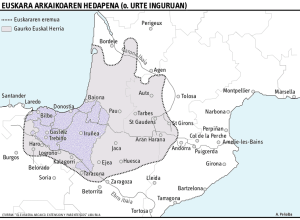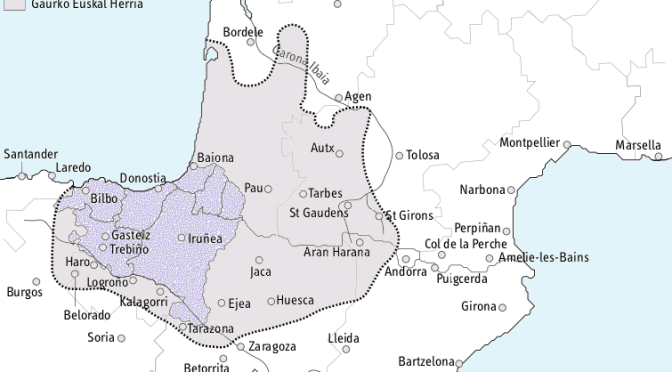A few weeks ago, I introduced Koldo Mitxelena, who was the chief architect of the reconstruction of Proto-Basque, the Basque that was spoken some 2000 years ago. So, what is Proto-Basque, exactly, and how do people like Mitxelena reconstruct a form of a language that is 2000 years old when there are no, or at best few, written resources from the time? Read on, dear reader, and take a journey back in time.

- The idea of Proto-Basque, called aitzineuskara in Euskara, was first broached by André Martinet but was fully developed by Koldo Mitxelena in the 1950s. By analyzing how words in Basque varied across the various modern dialects of the language, which provides a time capsule of sorts as to how words evolved over time, as well as how loan words from Latin evolved since Roman times, he was able to reconstruct what Basque must have looked liked some 2000 years ago. His reconstruction was validated when texts in Aquitanian were found and matched his Proto-Basque reconstruction very well; this also established Aquitanian as an ancestor of modern Basque.
- In his The History of Basque, Larry Trask summarizes several findings about Proto-Basque that are useful in both understanding the evolution of the language and in making attempts to relate Basque to other languages:
- No native Basque lexical item of any period (except for imitative items of no great antiquity) can begin with any of p-, t-, d- or r-.
- Virtually no native Basque lexical item of any antiquity can begin with k-.
- No native Basque lexical item in the period before the Roman invasion could contain m.
- No native Basque lexical item of any period can begin with any consonant cluster at all.
- Except in the eastern dialects, no native Basque lexical item of any antiquity can contain any of the cluster np, nt, nk, lp, lt or lk.
- The palatal segments are always secondary: they could not occur anciently in lexical items.
- These findings help linguists to better interpret the history of the language. For example, the fact that Proto-Basque had no ‘m’ means that any Basque words that do contain an ‘m’ are loan words from other languages. Looking at how those words have since evolved in the various dialects helps linguists reconstruct how other words must have evolved.
- Going even further back in time, to before contact with the Celtic languages, Joseba Lakarra has reconstructed Pre-Proto-Basque. It seems that modern Basque, and Proto-Basque, have a relatively large number of words that start with a vowel and in which that vowel is immediately repeated after a consonant. A couple of examples include adar (horn), odol (blood), and ihintz (dew). This fact has led Lakarra to postulate that Pre-Proto-Basque must have exhibited a lot of reduplication, or the repeating of initial syllables: da-dar, do-dol, ni-nin. He also suggests that, while in modern Basque the verb typically goes at the end of the sentence, in Pre-Proto-Basque it was at the beginning.
A full list of all of Buber’s Basque Facts of the Week can be found in the Archive.
Primary sources: Proto-Basque language, Wikipedia; Aitzineuskara, Wikipedia; The Proto-Basque Language, Kondaira.net
Discover more from Buber's Basque Page
Subscribe to get the latest posts sent to your email.


